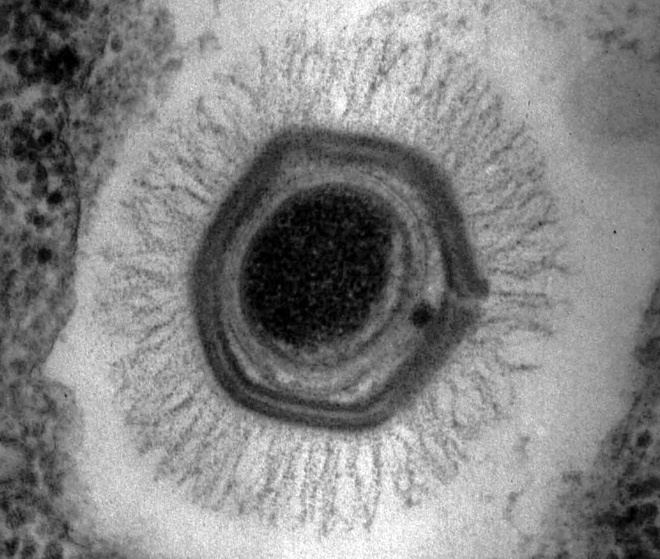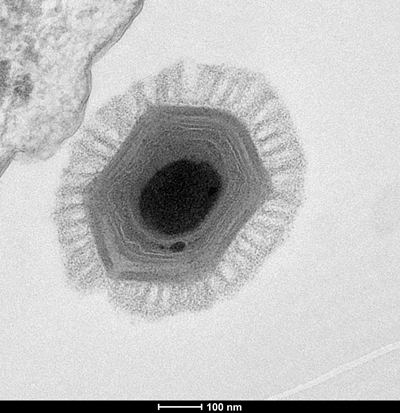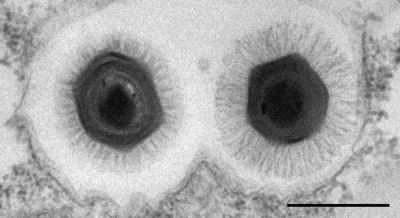Group Group I (dsDNA) Scientific name Megavirus Rank Genus | Family Megaviridae Higher classification Megaviridae | |
 | ||
Similar Mimivirus, Pandoravirus, Pithovirus, Mamavirus, Mollivirus sibericum | ||
Megavirus is a viral genus containing a single identified species named Megavirus chilensis (MGVC), phylogenetically related to Acanthamoeba polyphaga Mimivirus (APMV). In colloquial speech, MGVC is more commonly referred to as just “Megavirus”. Until the discovery of pandoraviruses in 2013 it had the largest capsid diameter of all known viruses, as well as the largest and most complex genome among all known viruses.
Contents
- Discovery
- Classification
- Structure
- Genome
- Replication
- Implications of discovery
- Table1 Largest giant viruses with complete sequenced genomes
- References

Discovery

Megavirus was isolated from a water sample collected in April 2010 off the coast of Chile, near the marine station in Las Cruces, by Prof. Jean-Michel Claverie and Dr. Chantal Abergel from the Structural & Genomic Information laboratory (IGS, CNRS and Aix-Marseille University). Researchers from this laboratory were already involved in the characterization of Mimivirus, the first described giant T2 Virus. Megavirus was isolated by co-cultivation with a variety of Acanthamoeba laboratory strains (A. polyphaga, A. castellanii, A. griffini) following a protocol pioneered by Dr. Timothy Rowbotham for isolating intracellular parasitic bacteria. Megavirus infects amoebas.
Classification

Megavirus is not yet classified by the International Committee on Taxonomy of Viruses, but will be proposed as a member of the Megaviridae, a new family constituted of the large DNA viruses the genome of which is around a million base pairs in length. Members of this new family defined by a number of common specific features (Table 1 and 2) will include various viruses likely to share a common ancestor with Mimivirus and Megavirus, although their present genome size was reduced below 1 Mb. Megavirus also joins a group of large viruses known as nucleocytoplasmic large DNA viruses (NCLDV), although this term appears increasingly inappropriate to designate viruses replicating entirely within the cytoplasm of their hosts through the de novo synthesis of large virion factories. Megavirus and Mimivirus share 594 orthologous genes, mostly located within the center segment of their genomes. At the amino-acid sequence level, the corresponding proteins share an average of 50% identical residues.
Structure

The Megavirus particle exhibits a protein capsid diameter of 440 nanometres (as seen by electron microscopy on thin sections of epoxy resin inclusions), enclosed into a solid mesh of bacterial-like capsular material 75 nm to 100 nm thick. The capsid appears hexagonal, but its icosahedral symmetry is imperfect, due to the presence of the “stargate”, at a single specific vertex of the icosahedron. The stargate is a five-pronged star structure forming the portal through which the internal core of the particle is delivered to the host's cytoplasm. This core is enclosed within two lipid membranes in the particle, also containing a large and diverse complement of viral proteins (e.g. the all transcriptional complex). Suprisingly, the Megavirus is larger than some bacteria, particularly the ones it preys on.
Genome
The Megavirus chilensis genome is a linear, double-stranded molecule of DNA with 1,259,197 base pairs in length. This makes it the second largest viral genome deciphered so far (after Pandoraviridae), outstripping the next-largest virus genome of Mamavirus by 67.5 kb. Prior validation of its transcriptome, it is predicted to encode 1,120 protein-coding genes, a number largely above the one exhibited by many bacteria.
However, beyond an incremental change in size, the Megavirus genome exhibits 7 aminoacyl tRNA synthetases (Table 2), the archetypes of enzymes previously thought only to be encoded by cellular organisms. While 4 of these enzymes were known to be present in Mimivirus and Mamavirus (for tyrosine, arginine, cysteine, and methionine), Megavirus exhibits three more (for tryptophan, asparagine, and isoleucine). Interestingly, the unique aminoacyltRNA synthetase encoded by Cafeteria roenbergensis virus corresponds to the one for isoleucine. Megavirus also encodes a fused version of the mismatch DNA repair enzyme MutS, uniquely similar to the one found in the mitochondrion of octocorals. This puzzling MutS version appears to be a trademark of the Megaviridae family. Like Mimivirus and CroV, Megavirus contains many genes for sugar, lipid and amino acid processing, as well as some metabolic genes not found in any other virus.
Replication
Megavirus replication stages closely follows the one already described for Mimivirus. Following rapid engulfing by phagocytosis, and the delivery of the particle core to the cytoplasm, begins the eclipse phase. A closer examination indicates the presence of cytoplasmic “seeds”, of sizes comparable to the most internal membrane-enclosed core of the Megavirus particle. These seeds then develop in full bloomed virion factory over the following 14 hours. The full course of infection (until the complete lysis of the amoebal cells) takes 17 hours on average, compared to 12 hours for Mimivirus. The average number of released Megavirus particles (i.e. the “burst size”) is about 500, half the thousand released by Mimivirus.
As expected from a virus encoding its own complete DNA replication, repair, and transcription machinery, the host nucleus does not appear to be involved in any of Megavirus replication stages, as already seen for Mimivirus.
Implications of discovery
Two Megavirus specific features are of fundamental importance. First, even if its new record-sized genome only represent a small 6% increment compared to the second largest Mamavirus genome, it indicates that we have not yet reached the limit of viral genome sizes, and that even more complex viruses may remain to be discovered, most likely in aquatic environments, the viral diversity of which has been barely scratched by recent metagenomic studies.
Second, the presence of three additional aminoacyltRNA synthetases in the Megavirus genome, with a total of seven, definitely rules out their independent acquisition by lateral transfer from a host. In addition, the phylogenic analysis of their amino acid sequences does not cluster them with any known protozoan clade, but rather connect them deeply to eukaryotic domain.
The conclusion then becomes inescapable that the genome of these giant viruses originated from an ancestral cellular genome (thus endowed of a translation apparatus, with all 20 aminoacyl tRNA synthetases) from which today’s Megaviridae derived by a number of lineage specific genome reduction events, a scenario akin to the one followed by all parasitic organisms. As indicated by the deep rooting of their phylogeny, the Megaviridae lineage might be very old, possibly predating the emergence of eukaryotes, or contemporary with and possibly linked to that emergence. Alternatively, it could be derived from an extinct cellular domain (the controversial 4th domain of the Tree of Life), many genes of which would have managed to persist in today’s giant viral genomes.
Table1: Largest giant viruses with complete sequenced genomes
The whole list is in the Giant Virus Topist created by the Giant Virus Finder software.
